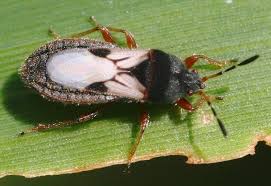
Adult chinch bug.
Chinch bugs are small insects that usually infest lawns as well as cause damage to crops such as wheat, oats or corn. These pests have hard bodies about 1/6 of an inch thick when they are adults and two pairs of wings on their back. Within a year, they can produce up to three generations. When infestation occurs these insects can be as numerous as 200 pests per square foot.
But how can home owners spot such bugs? And more importantly, how can you prevent chinch infestation in your lawns?
A Chinch Bug’s Life Cycle
Chinch adults spend their winters among leaves where they make shelter and wait for warm. When spring arrives, they emerge. This is the time in which they mate and lay their eggs, with as much as 300 eggs being produce in less than 2 months.
The female chinch bugs deposit eggs within the ground and leaves of lawn thatch or other host plants. Afterwards the eggs hatch, resulting in nymph chinch bugs that will mature into adults within 6 weeks. Both nymphs and adult chinchs feed on grass, making them a formidable pest in all stages of their life cycle.
How do Chinch Bugs Cause Damage to Lawns
Chinch bug pests cause damage to turf grass in two main ways through 1) the toxins they release into plants that damage plant tissue as they feed and 2) by sucking plant juice from their host plant.
In fact, their bodies seem to be built for plant destruction. All species of chinch bugs have specialized mouthparts which allow them to both pierce plant tissue and suck juices from the plant. This feature is common in most bugs like chinchs that fall within the “true bug” category of insects. The fact that they are so small as well with coloration that makes it easy for them to blend into turf grass also makes them even more formidable.
The most dangerous of its kind is the hairy chinch bug also known as Blissus leucopterus hirtus. This species infests lawns as it blends into thatch – the section of the lawn with intermingled layers of dead and living shoots and stems. Since Blissus chinchs attacks sunny areas of turf during hot, dry periods, it makes it difficult to recognize the real source of the issue when homeowners live in areas of drought. Note also that hairy chinch bugs prefer the following types of turf grass:
- Kennedy bluegrass
- Perennial ryegrass
- Red fescues
- Bentgrass
How to Verify If Chinch Bugs are the Cause of Lawn Damage
A chinch pest infestation is not too difficult to detect once homeowners know what to look for. Usually, the first signs of damage occur months after infestation and manifest themselves through discoloration in turf grass. When this discoloration becomes widespread and other damage is present, it is recommended that you check turf for signs of the insect.
The most obvious signs of chinch bug infestation include the following:
- Grass turns yellow or reddish-brown
- Damage beginning to appear in grass during summer times (early July to end of August)
- Large patches of dead, brown lawn grass
- Presence of chinch nymphs and adults in lawn or turf grass
How to Get Rid of Chinch Bugs
Now here’s the challenge. You’ve spotted the culprit that’s turning your lawn into ruin but what do you do next? Some owners may be quick to apply insecticides or pesticides – any products they hear can do the trick.
First, be sure the bugs you spot are really chinch bugs:
The only successful pest control plan is the one that identifies and treats the right pest. For this reason, it’s important to be sure which insect is really at work in your lawn. Pest control professionals are able to identify pests by looking for key features and characteristics. They may also take samples of your lawn turf to be sure which pest is present.
Second, find out which pest management technique is most effective and safe:
There are numerous options available for the treatment of chinch infestation including the use of cultural, biological and chemical treatment. For instance, some pest control professionals have used the endophyte-enhanced seed (cultural approach), a cinch bug predator called the big-eyed bug (biological) or insecticides (chemical) to reduce chinch population in homeowners’ lawns. Be sure to ask which options are available before choosing which approach you would like to be taken.

No Comments